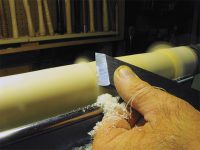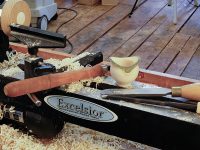Issue 607
Issue 607
The Hard Stuff
 Woodturning is fun and satisfying to me. It suits my short attention span and allows for creativity on the fly. It’s also something you can do in a smaller space and does not require tons of equipment. I like it for so many reasons.
Woodturning is fun and satisfying to me. It suits my short attention span and allows for creativity on the fly. It’s also something you can do in a smaller space and does not require tons of equipment. I like it for so many reasons.
Recently I was asked to try out some of the Negative Rake Cutters from Easy Wood Tools. I had heard about them, but other than knowing that they feature a “special” grind on their carbide tips, I was in the dark about the technology. They were created to deal with very hard woods and materials like resin or plastic.
The videos below offer up what I found out about the cutters and show some of my first attempts at turning acrylic. I hope you’ll find my learning experience as interesting as I did. Now I can’t wait to give the Negative Rake Cutters a go on some lignum vitae that I have in my shop … that stuff is super dense and very hard.
Rob Johnstone, Woodworker’s Journal
![]()
Turning Acrylic Blanks with Negative Rake Carbide Turning Tools
Installing a Threaded Insert into an Acrylic Turning Blank
![]()
Woodturning
-

Skew Chisel Primer
Keith Tompkins of the American Association of Woodturners gives an overview of how to get the most out of the oft misunderstood skew chisel.
-

Turning a Bird’s Mouth Bowl
Mimic baby bird beaks with easy turnings from tree limbs.







